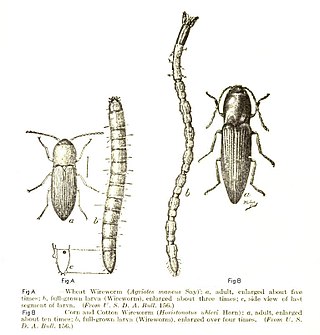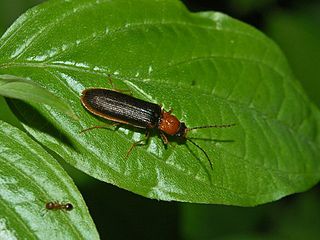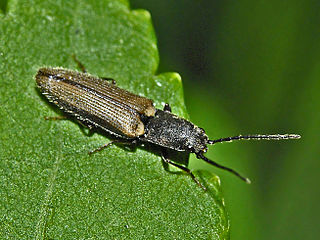
Pollarding is a pruning system involving the removal of the upper branches of a tree, which promotes the growth of a dense head of foliage and branches. In ancient Rome, Propertius mentioned pollarding during the 1st century BCE. The practice has occurred commonly in Europe since medieval times, and takes place today in urban areas worldwide, primarily to maintain trees at a determined height or to place new shoots out of the reach of grazing animals.

Elateridae or click beetles are a family of beetles. Other names include elaters, snapping beetles, spring beetles or skipjacks. This family was defined by William Elford Leach (1790–1836) in 1815. They are a cosmopolitan beetle family characterized by the unusual click mechanism they possess. There are a few other families of Elateroidea in which a few members have the same mechanism, but most elaterid subfamilies can click. A spine on the prosternum can be snapped into a corresponding notch on the mesosternum, producing a violent "click" that can bounce the beetle into the air. Clicking is mainly used to avoid predation, although it is also useful when the beetle is on its back and needs to right itself. There are about 9300 known species worldwide, and 965 valid species in North America.

Apatura iris, the purple emperor, is a Palearctic butterfly of the family Nymphalidae.

The Blue Mountains tree frog also called the variegated river tree frog is a species of tree frog in the subfamily Pelodryadinae. It is endemic to southeastern Australia and is found in eastern Victoria and in southeastern New South Wales. The Jenolan Caves tree frog, a population formerly separated as Litoria jenolanensis, is nowadays included in this species.

The brubru is a species of bushshrike found in most of Sub-Saharan Africa. It is the only member of the genus Nilaus.

Athous haemorrhoidalis is a species of European and Asian click beetles in the genus Athous. Several variations are recognized.

Calopteryx haemorrhoidalis is a species of damselfly in the family Calopterygidae known by the common names copper demoiselle and Mediterranean demoiselle.

Alaus oculatus, commonly called the eastern eyed click beetle or eyed elater, is a species of click beetle.

Agrypnus murinus is a species of click beetle belonging to the family Elateridae subfamily Agrypninae.

Denticollis linearis is a species of click beetle belonging to the family Elateridae subfamily Dendrometrinae.
Athous axillaris is a species of click beetle from the family Elateridae. It was described by George Henry Horn in 1871 and is endemic to California.
Athous austriacus is a species of brown-coloured click beetle from the family Elateridae. The species is 10.5 millimetres (0.41 in) long and is found in Hochschwab, Austria.
Athous caviformis is a species of brown-coloured click beetles which can be found in Hungary, Croatia, and Bosnia and Herzegovina.
Athous tauricola is a species of brown-coloured click beetle from the family Elateridae which can be found on the Crimean peninsula and Ukraine.
Athous turcicus is a species of brown-coloured click beetle of the family Elateridae known from North Macedonia and Greece. It is 13 millimetres (0.51 in) long.

Athous bicolor is a species of click beetle.

Dermestes ater is a species of beetle in the family Dermestidae, the skin beetles. It is known commonly as the black larder beetle or incinerator beetle. It is native to North America, but today it is found nearly worldwide. Like several other dermestid beetles, this species is a common pest of stored products.

Elater ferrugineus, the rusty click beetle, is a species of click beetle belonging to the family Elateridae.

Athous emaciatus is a species of click beetle in the genus Athous.














